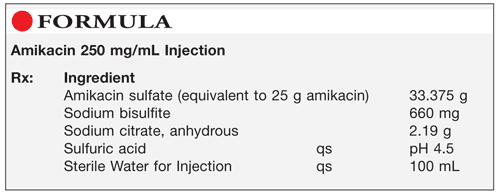US Pharm. 2011;36(11):54-55.

Method of Preparation: Note—This formulation should be prepared according to strict aseptic compounding technique in a laminar airflow hood in a cleanroom or via isolation barrier technology by a compounding pharmacist validated in aseptic compounding. This is a high-risk preparation.
Calculate the quantity of each ingredient for the amount to be prepared. Accurately weigh each ingredient. Dissolve the amikacin sulfate, sodium bisulfite, and sodium citrate in about 90 mL Sterile Water for Injection. Adjust the pH with sulfuric acid to a pH of 4.5. Add sufficient Sterile Water for Injection to volume; mix well. Filter through a 0.22-micron filter into sterile single-use vials (single-use vials are necessary since this injection is not preserved). Package and label.
Use: Amikacin injection is used to treat susceptible gram-negative bacterial infections.
Packaging: Package in sterile, tight, single-use containers.
Labeling: For professional use only. Keep out of the reach of children. Discard after ____ [time period].
Stability: The commercially manufactured product contains nitrogen in the headspace to minimize the discoloration caused by oxidation; however, this color change does not affect the potency of the preparation.1
If sterility testing is not done, a beyond-use date of up to 24 hours may be used if the preparation is stored at controlled room temperature, or not more than 3 days at a cold temperature. If the preparation is sterility tested, a beyond-use date of up to 6 months may be used.2 However, a shorter beyond-use date should be considered, as discoloration from oxidation may occur.
Quality Control: Quality-control assessment can include weight/volume, physical observation, pH, specific gravity (SG), osmolality, assay, color, clarity, particulate matter, sterility, and pyrogenicity.3,4
Discussion: In short supply recently, amikacin is a semisynthetic aminoglycoside antibiotic derived from kanamycin A; it is commercially available as a sulfate salt. Amikacin injection is a colorless to pale yellow or light straw-colored solution that can be sterilized by filtration or autoclaving. Amikacin injection should be stored at room temperature. The solution becomes light straw-colored during storage, but this does not indicate a loss of potency. Common commercial concentrations of amikacin are 50 mg/mL and 250 mg/mL.4
Amikacin sulfate (Amikin, C22H43N5O13.2H2SO4, MW 781.76) occurs as a white, crystalline powder that is freely soluble in water. It contains the equivalent of not less than 674 mcg and not more than 786 mcg amikacin per mg, calculated on the dried basis. On drying, it loses not more than 13.0% of its weight. It is important to check the label of the bulk amikacin sulfate powder to determine the equivalent amount to be used. Amikacin sulfate should be preserved in a tight container. The injection is colorless to light straw-colored and has a pH ranging from 3.5 to 5.5.5
Sodium bisulfite (sodium hydrogen sulfite, NaHSO3, MW 104.07) occurs as a white, crystalline powder. It is soluble 1 in 3.5 parts of water and in 70 parts of 95% alcohol. Most substances sold as sodium bisulfite contain significant but variable amounts of sodium metabisulfite; sodium metabisulfite is less hygroscopic and more stable during storage and shipment. Sodium bisulfite generally is used as an antioxidant in solutions of intermediate pH.6
Sodium citrate (trisodium citrate, C6H5Na3O7, MW 258.07, anhydrous; dihydrate, MW 294.10) occurs as colorless crystals or as a white, crystalline powder. The hydrous form is freely soluble in water (1 g in 1.5 mL), highly soluble in boiling water (1 g in 0.6 mL), and insoluble in alcohol. Sodium citrate is stable and can be sterilized by autoclaving. When sodium citrate is stored in a glass container for a period of time, separation of small, solid particles may occur. The bulk material should be stored in an airtight container in a cool, dry place. Each gram of dihydrate represents approximately 10.2 mmol sodium and 3.4 mmol citrate; each gram of anhydrous represents about 11.6 mmol sodium and 3.9 mmol citrate.7
Sulfuric acid (oil of vitriol, H2SO4, MW 98.08) occurs as a clear, colorless, oily liquid that is miscible with water and alcohol with the generation of heat. It is highly caustic and corrosive. Sulfuric acid has an SG of about 1.84 and is used as an acidifying agent. It is hygroscopic and contains not less than 95% and not more than 98% of H2SO4 by weight, the remainder being water. Sulfuric acid is a powerful oxidizer; it may ignite or explode upon contact with numerous materials.2
REFERENCES
1. Niazi SK. Handbook of Pharmaceutical Manufacturing Formulations, Volume 6—Sterile Products. Boca Raton, FL: CRC Press; 2004:73.
2. USP Pharmacists’ Pharmacopeia. 2nd ed. Rockville, MD: US Pharmacopeial Convention, Inc; 2008:775-779,779-831,1463.
3. Allen LV Jr. Standard operating procedure for particulate testing for sterile products. IJPC. 1998;2:78.
4. Allen LV Jr. Standard operating procedure: quality assessment for injectable solutions. IJPC. 1999;3:406-407.
5. McEvoy GK. AHFS Drug Information 2010. Bethesda, MD: American Society of Health-System Pharmacists; 2010:72-75.
6. Kabir MA, Reo JP. Sodium metabisulfite. In: Rowe RC, Sheskey PJ, Quinn ME, eds. Handbook of Pharmaceutical Excipients. 6th ed. London, England: Pharmaceutical Press; 2009:654-656.
7. Amidon GE. Sodium citrate dihydrate. In: Rowe RC, Sheskey PJ, Quinn ME, eds. Handbook of Pharmaceutical Excipients. 6th ed. London, England: Pharmaceutical Press; 2009:640-642.
To comment on this article, contact rdavidson@uspharmacist.com.





